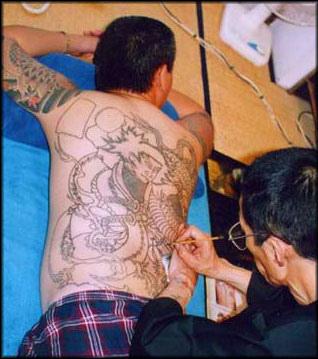
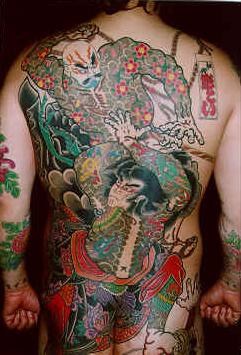
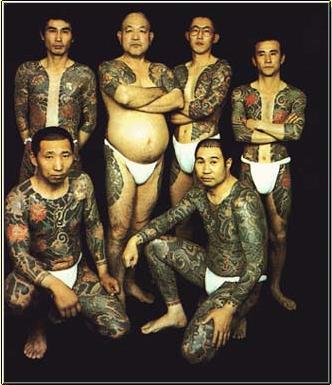

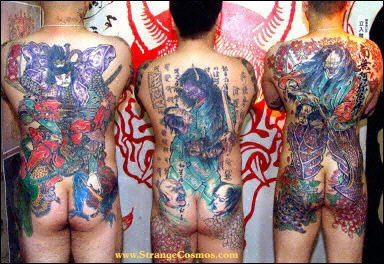
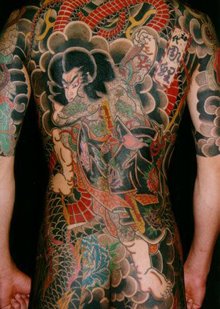
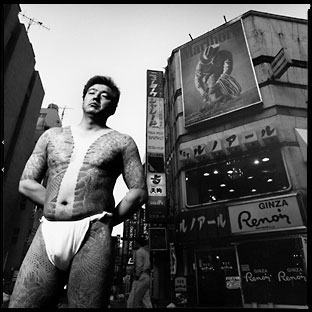









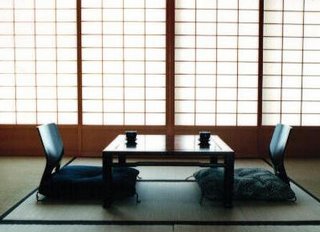 The man who brought peace between many of the yakuza factions was named Yoshio Kodama.
The man who brought peace between many of the yakuza factions was named Yoshio Kodama.
It exists two types of yakuza, clan- yakuza and freelance yakuza.
Freelance yakuza
Freelancing yakuza is a yakuza that not commit any bigger crimes and belongs to a little group of hustlers.
They have however some difficulties to survive or not come into jail, because the clan- yakuza not allows anyone other to operate within their territories. Clan- xakuza can tip the police about crimes that the freelance yakuza haven´t commit.
If the freelance- yakuza earns to much money, the clan- yakuza kills the freelancing- yakuza or make him disappear without a trace.
A freelance- yakuza can also be used as a scapegoat if it acquires a guilty to a crime.
If a freelancer is a truly genius he can manage to begin his own clan. Usual a freelance- yakuza becomes, if they not gets killed,a member in a clan.
 Yubitsume, or finger-cutting, is a form of penance or apology. If a gambler couldn't pay back a debt or something like that the persons tip of the little finger got cut off, which damage the hand and the person could not hold his sword as well as before. Also that way other people could see if a person haven't paid a debt, which could bring certain problems, since gambling always been prohibited in Japan.
Yubitsume, or finger-cutting, is a form of penance or apology. If a gambler couldn't pay back a debt or something like that the persons tip of the little finger got cut off, which damage the hand and the person could not hold his sword as well as before. Also that way other people could see if a person haven't paid a debt, which could bring certain problems, since gambling always been prohibited in Japan. 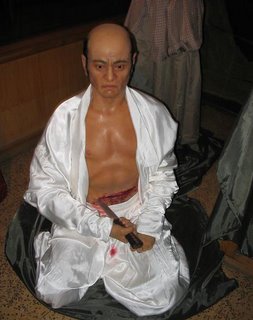 Another, more radical version of penance is seppuku (also known as hara-kiri ), ritual suicide by disembowelment. Popular among Japanese samurai and soldiers who would commit it as penance for their failures, Yakuza are sometimes known to commit seppuku as well.
Another, more radical version of penance is seppuku (also known as hara-kiri ), ritual suicide by disembowelment. Popular among Japanese samurai and soldiers who would commit it as penance for their failures, Yakuza are sometimes known to commit seppuku as well.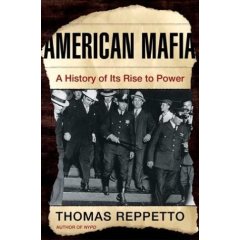 Yakuza became influenced by the American gangster- movies and began to dress in black suits with white shirts, black sunglasses and cropped hair
Yakuza became influenced by the American gangster- movies and began to dress in black suits with white shirts, black sunglasses and cropped hairThere is no single origin for all Japanese yakuza. Rather, yakuza organizations developed from different elements of traditional Japanese society.
Kabuki-Mono
Yakuzas origin can be followed far back as to the year 1612, when men known as kabuki-mono (the crazy ones). Their odd clothing style, the distinct haircuts and bad behavior, longswords quickly got everybody's attention. They were known as masterless samurais, ronin, and several of them began to wander around in Japan as a band of robbers, plundering villages and small cities. Kabuki-mono generally came from shoguns or samurais whom during long peaceful times were forced into unemployment. Almost all yakuza have the same type of background poor, criminals and misfits. The Yakuza became a family for them. They got help with problems, got attention and could feel a certain saftey
Yakuza however not see kabuki-mono as their "ancestors" instead they feel that they are machi-yakko(City servant), Machi-yakko became the people's heroes, praised by the citizens for their help against kabuki-mono. The Machi-yakko were often weaker, far less trained and equipped than kabuki- mono. Therfore they were compared with England's Robin Hood. Kabuki-mono were known for their ruthless behavior and terrorizing all the surrounding areas. They were well known for stabbing people for pleasure. Kabukimono were gave their groups scary names and spoke in vulgar slang.